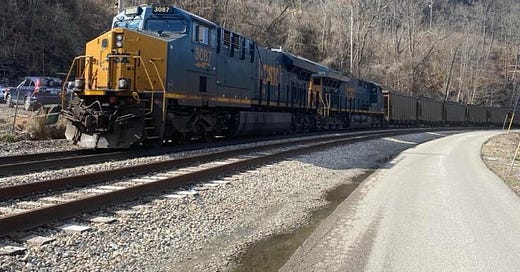Shaping Land Futures: Eastern Kentucky Community College Students Reflect on Transitioning Landscapes
Maya Weinberg, MS student at the Pennsylvania State University
I spent my childhood and two years of college living within a mile of the University of North Carolina’s Cogeneration Facility (Sorrell, 2024). My route to school, first as a child and again as a college student, was often blocked by the Norfolk Southern Line, on its way to deliver coal to the facility from eastern Kentucky (Kentucky Energy and Environment Cabinet, 2017). This experience made me curious about the interconnected stories of energy transitions at both ends of the supply chain. While my hometown adapts to new energy sources, communities in eastern Kentucky are redefining their relationships with land in the midst of the declining multi-generational mining industry.
Reading Sarah Plaut’s 2023 blog post in Just Rural Futures, I was enthusiastic to see how other student researchers are working with young people to tell stories of the “multi-faceted realities of rural life” in the midst of transitions (Plaut, 2023). Having previously worked with youth as a career adviser, I collaborated with several community colleges and learned about their unique role in rural livelihoods. As institutions supporting local economic growth through workforce development, community colleges often aim to prepare their students to thrive in their home communities (Hazard Technical and Community College). Wright (2012) explores the concept of “becoming to remain” or “using [community college] degrees towards local, transformative ends” as a means of pushing back on the narrative of “brain drains” often ascribed to rural areas.
To further explore these themes, in the summer of 2024, I began a research project in partnership with a community college instructor and local citizens action organization dedicated to increasing access to outdoor recreation in Perry County, Kentucky. Once one of the most heavily surface-mined counties in Kentucky, there are currently about six mines still in operation. This drastic change in land use leaves behind flattened terrain in a region otherwise defined by steep topography. To understand how community college students are understanding and responding to this transition, we conducted three focus group discussions with thirty students utilizing participatory mapping followed by a photovoice activity for students to reflect on their relationship to land- past, present, and future. While still in the early stages of analysis, several key themes have emerged.
When considering desired land imaginaries, focus groups first discussed how they have formed relationships with their local natural environment. In the absence of standardized environmental education courses in school, students shared that most of their learning occurs in informal settings through inter-generational relationships and recreation, predominantly hiking, riding all-terrain vehicles (ATVs), hunting, and foraging.
“So, I grew up going on ATV rides with my papaw [grandfather] and brother... And we would camp there... we've got an old strip job there. He would just show me... what ginseng looks like, what different mushrooms look like, stuff like that.” (FG 2)
In placing significant value on access to land for recreational purposes and, therefore, wellbeing, students cited concerns for the waning of this access when describing active land repurposing that they observe on reclaimed surface mines. As students imagined future land relations, they often noted how what they imagine doesn’t mean much because corporate land ownership and extra-local developers limit who has a say in shaping local landscapes. While they showed an interest in reclaimed surface mines being used for more “sustainable” infrastructure or conservation-oriented activities, students pointed to an oversimplification of what sustainability means and a lack of local input and benefits they currently see such sectors valuing.
“I went to that solar meeting with Starfire, I mostly stay out of it, it’s only temporary jobs, and power won’t go to KY. I can’t really tell you how it went, but Starfire won.” (FG 2)
The focus group discussions reveal not only how students view their relationship to land but also how they envision—and challenge—its future uses. These insights are essential as the region navigates a just energy transition. By exploring these themes further, we can begin identifying actionable steps to address the challenges students have raised. They lead to further questions of how local voices, particularly those of young people, can be amplified and centred in conversations about sustainability and how institutions like community colleges help ensure that these visions are not just heard but realized. By exploring these questions, I hope to contribute to a future where land imaginaries are not imposed but collaboratively built—by and for those who live, work, and dream there.
“We care about the environment ourselves. It's just, it's just the coal industry is all we had. And so now, now that there are more resources available to care for it, people are starting to warm way up to it.” (KI 5)
— Maya Weinberg
Author’s Bio

Connect with us at:
Thanks for reading Just Rural Futures! Subscribe for free to receive new posts and support my work.





